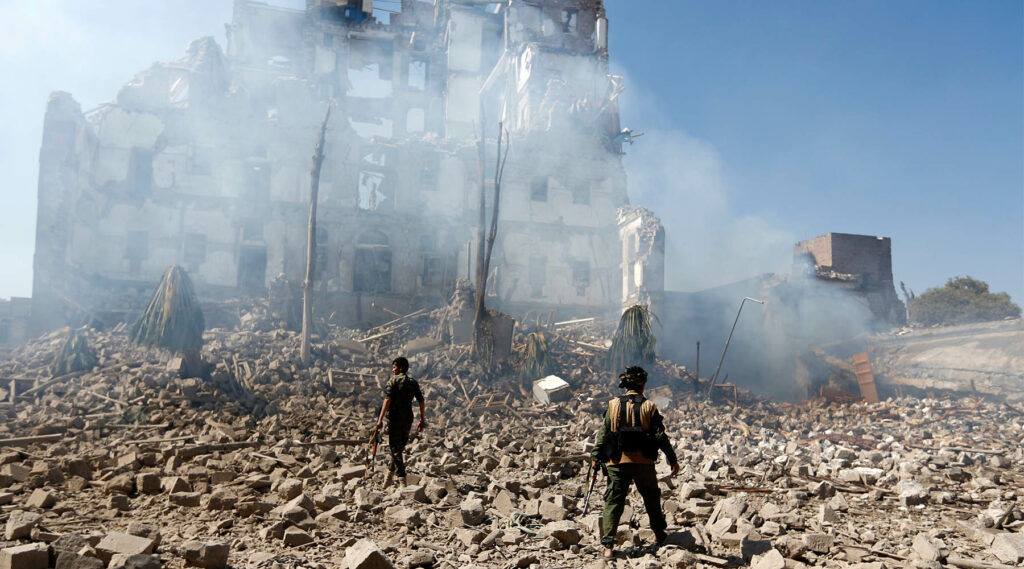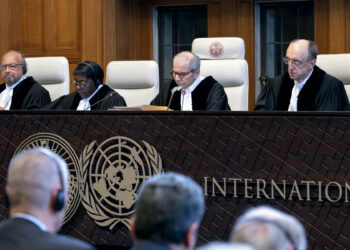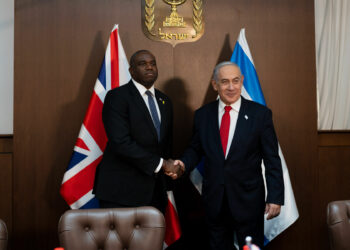Simon Mabon is Professor of International Politics at Lancaster University, where he directs the Sectarianism, Proxies and De-sectarianization (SEPAD) project and the Richardson Institute.
عربي
In 1993, Foreign Affairs published a sweeping essay by American political scientist Samuel Huntington that went on to become something of a textbook for U.S. officials in the aftermath of 9/11: "The Clash of Civilizations?". Predicated on six overarching premises about "civilization identity" and its inherent "cultural fault lines," Huntington's thesis set out a vision of world politics based on fundamental tensions between different civilizational blocs that were monolithic and static, pitting primordial identities against one another. Despite the myriad intellectual and political issues with his claims, Huntington expanded his article into a book that gained a great deal of prominence in the post-9/11 world. But he had plenty of critics, like Ken Booth, the prominent British international relations theorist, who called The Clash of Civilizations and the Remaking of World Order "the worst book on world politics I have read in a long time."
Writing in Foreign Affairs almost 30 years later, Vali Nasr, the Majid Khadduri Professor of Middle East Studies and International Affairs at the Johns Hopkins University School of Advanced International Studies, sets out a similarly problematic narrative, albeit focusing specifically on the Middle East. The essay, "All Against All: The Sectarian Resurgence in the Post-American Middle East," is an argument for continued U.S. involvement and intervention in a region that Nasr sees solely in sectarian terms. "The United States' disengagement," he warns, "threatens to leave a political vacuum that will be filled by sectarian rivalries, paving the way for a more violent and unstable region." Besides that troubling premise, the bigger issue is Nasr's perpetuation of an argument that seeks to understand complex conflicts and divisions across the Middle East, and the broader Muslim world, through the all-encompassing idea of sectarianism.
Nasr is no stranger to writing on this topic. He is the author of the 2006 book The Shia Revival: How Conflicts Within Islam Will Shape the Future, and has published extensively across prominent policy outlets. His resume is equally impressive: advising senior U.S. officials, including the president, and regularly appearing on prominent TV shows. The problem emerges with the narrative at the heart of his work, which presents a vision of the Middle East divided along fixed sectarian lines, pitting Sunni against Shi'a through the contemporary emergence of what President Barack Obama referred to as "conflicts that date back millennia," evoking the myth of "ancient hatreds." Nasr, who advised Obama during his first term, has evoked that cliché himself by writing about "the old feud" between Sunni and Shi'a, which he sees as the defining feature of political, social and economic life in the region.
Since 2018, I have worked with colleagues around the world under the banner of the Sectarianism, Proxies and De-sectarianization (SEPAD) project based at Lancaster University's Richardson Institute to study the rise of sectarian violence, generously funded by Carnegie Corporation. Along with colleagues from the Middle East, across Europe and the U.S., we have undertaken research, produced reports, books, articles, opinion pieces and engaged in discussions with policymakers to try and better understand the deeper dynamics behind sectarian violence and proxy conflicts that are shaping the region.
One such colleague, Morten Valbjorn of Aarhus University in Denmark, half-jokingly referred to the emergence of "Sectarian Studies" given the amount of literature produced on the topic in recent years. In some ways, he is not wrong. A whole range of scholars have all produced rich scholarly work based on extensive interviews and theoretical analysis. None has reached the same conclusion as Vali Nasr; going a step further, most have reached dramatically different conclusions. Most academic work on the topic would broadly agree that sectarian difference is a product of the manipulation of religious identities by people and governments acting in pursuit of their own interests, shaped by contextual factors, meaning that the manifestation of sectarian difference varies across time and space. Yet Nasr fails to engage with this literature, or even acknowledge its existence.
While there are no doubt conflicts taking place between groups from different sectarian backgrounds, sectarian difference alone is not the reason for conflict in the region.
- Simon Mabon
Most scholars studying sectarianism reach the view that while religion matters—and it does—we must locate political identities within broader political issues about belonging, governance, basic needs and geopolitics. Amid increasingly precarious political conditions brought about by authoritarianism, rampant corruption and geopolitical rivalries, sectarian identities took on importance as a means of cultivating cross-border relationships in pursuit of power, or dividing groups, as evidenced in Syria, Bahrain and Yemen. Of course, sectarian or communal identities are not ephemeral, only emerging when mobilized by certain antagonists and then disappearing afterwards. They resonate across societies and the region because they carry normative value. But this value is shaped by context and is subject to change, a point which the primordialist aspect of Nasr's work misses.
There are still times when Nasr's analysis is accurate. The struggle for geopolitical primacy between Iran and Saudi Arabia has had a devastating impact on politics and people across the Middle East, yet it is not a rivalry solely couched in religious terms. Religion, as Nasr acknowledges at certain points, is instrumentally deployed by those seeking influence and power. But this is not something that is static or homogenous. Rather, the mobilization and manifestation of sectarian divisions is a consequence of the peculiarities of local context, rather than of an "old feud." Although at times Nasr seeks to acknowledge the complexity of issues at play—notably the "weaponization of Islam"—his arguments quickly slip back into the frame of "sectarian conflicts," "sectarian rivalries" and a "sectarian powder keg."
Yet the conflicts in Syria and Yemen, two of his key examples, are not fundamentally sectarian. Although actors in both countries have sought to mobilize sect-based identities in pursuit of their own interests, allowing conflicts to take on a sectarian component, the roots of division in Syria and Yemen are more typically concerned with governance, access to state largesse, and the lack of democratic accountability and reform. As my recent book argued, the protests that drove the Arab uprisings of 2011 were a consequence of popular frustration—with broken political processes and the failure of authoritarian regimes to meet basic needs. The counterrevolutionary response of regimes, from Syria to the Gulf, was driven by the mobilization of machineries of control honed over previous decades. The construction of sect-based difference is one such mechanism, often deployed in the face of cross-sectarian protests such as those seen in Bahrain in 2011, where the refrain of "not Sunni, not Shi'a, just Bahraini" was heard across the island.

Counterrevolutionary movements led by Saudi Arabia and the United Arab Emirates, operating with the tacit approval if not outright backing of the United States and United Kingdom, manipulated this difference by framing particular actors—such as Iran, Hezbollah and the Houthis—as "existential threats" to peace and security. They then used that to justify military force in support of their stated allies—and to counter gains made by their geopolitical rival, Iran. As one Emirati woman told me, Saudi Arabia and the UAE went to war in Yemen out of fears that "we are next." This fear was not about sectarian difference, but regional security. The cultivation of sectarian difference is a product of regional competition and efforts to ensure regime survival, whether in Riyadh or Tehran. Yet Nasr's recent piece in Foreign Affairs paints a different picture, casting regional rivalries as reducible to those between fixed Sunni and Shi'a states. While there are no doubt conflicts taking place between groups from different sectarian backgrounds, sectarian difference alone is not the reason for conflict in the region.
Although this critique may appear academic, or semantic, arguments like Nasr's reproduce a clichéd narrative of "old feuds" and immutable "hatreds" rooted in Islam itself that ignores the complexities of everyday life, creating problematic and even Orientalist assumptions about Islam in the process, associating the religion inherently with violence. Moreover, the reductive framing of Iran as a "Shi'a" power, in contrast to "Sunni" states, fails to acknowledge the diverse and complex demographic makeup across the region and within these societies, reducing any and all identity to religion alone. For example, although a large majority of Iranians are Shi'a, and follow certain Islamic doctrine, their broader identity as Muslims is perhaps more pervasive and even more important. Moreover, simply describing Iran as "Shi'a" ignores the diverse ethnic makeup of the country, which has resulted in a rich cultural history and a far from monolithic political environment. Persians are Iran's largest ethnic group, making up about 50 percent of Iran, but there are nearly a dozen other ethnicities, including Azeris, Kurds, Arabs, Baluchis and Lors. Similarly, in what he broadly terms "Sunni Arab states," Nasr ignores Shi'a groups, tribal groups, class and regional identities, and other faiths.
Consider the protesters who took to the streets of Lebanon and Iraq in recent years. One popular Lebanese protest chant—"all of them means all of them"—was a call for the entire political class, across Lebanon's confessional system, to resign. In Iraq, another chant—"we want a country"—was a sweeping demand to end both Iranian involvement in Iraqi affairs and the corrupt, sectarian power-sharing political order installed under the U.S. occupation. Here was a broad rejection of the dominance of sectarianism in politics and, also, a vehement rebuttal of the role of outside actors. Lebanese and Iraqi protesters were furious at rampant corruption, democratic inertia, a lack of reform, violence and the meddling of Iran—and Saudi Arabia—in their country's political life.
This isn't a schism between "Shiism" and "Sunnism," as Vali Nasr puts it, but between those with power and those without it. That is the fundamental struggle in the Middle East today.
- Simon Mabon
Rather than focus on these grassroots movements that reject sectarianism outright and disrupt the narrative of "sectarian conflicts," Nasr fixates more on proxy wars. He is not alone in reducing conflicts like Yemen's to a proxy war between Saudi Arabia and Iran, arguing that these regional powers have developed patron-client relationships with local actors. But in many cases, this overly simplistic view of such relationships does not accurately depict actions on the ground. As the Lebanese political scientist Amal Saad has noted, the proxy war model fails to acknowledge the complexity of relationships developed through shared identities, norms, culture, visions of order and discourse, reducing them to crude material interest shaped by military and economic capacity. For example, Hezbollah in Lebanon and the Houthis in Yemen are both often referred to as Iranian proxies, but the actions of both groups have, at times, gone against Tehran's wishes.
In Bahrain, Shi'a protesters have regularly been framed as Iranian agents, much to their anger. One Shia cleric in Bahrain told me it was "deeply offensive" to refer to him as an Iranian agent provocateur—which, revealingly, is also what the ruling Al Khalifa monarchy calls its critics. Such anger is not restricted to Bahrainis. Indeed, Yemenis, Lebanese, Syrians and Iraqis have all sought to assert their own agency, rather than be cast as pawns or proxies of some outside sectarian power.
There is little doubt that what Nasr calls "a new security arrangement" is necessary for regional stability. Yet Nasr's doomsday view of sectarianism misses the pragmatism in both Saudi Arabia and Iran today. With both countries' economies under pressure to reform, there are strong currents in Riyadh and Tehran that recognize and accept the need to talk and work with one another. Diplomatic dialogue is ongoing, and while there are still important steps to take, there are signs of progress.
While the interplay of regional and domestic politics is essential to understanding conflicts and rivalries in the region, the kind of primordial account pitting Shi'a against Sunni fails to seriously engage with the state as the main arena of this interaction. As data from both the Arab Barometer and the Arab Opinion Index shows, there is widespread domestic anger at the state across the Middle East—from its governance failings and corruption, to its inability to meet the basic needs of its population. The Arab uprisings opened up schisms between rulers and ruled that continue to this day, and have fueled regional turmoil over the past decade. At the heart of these schisms are different visions of political life itself—from the role of religion in politics, to calls for political and economic reform, to greater democratic engagement.
This isn't a schism between "Shiism" and "Sunnism," as Nasr puts it, but between those with power and those without it. That is the fundamental struggle in the Middle East today. There are sectarian overtones, of course, but to say it is all about sectarianism is to perpetuate as monolithic a claim as a "clash of civilizations." The deeply flawed assumptions about "old feuds" and immutable identities profoundly misunderstand the region and will ultimately lead to dangerous policy choices, breeding further violence and suffering.







